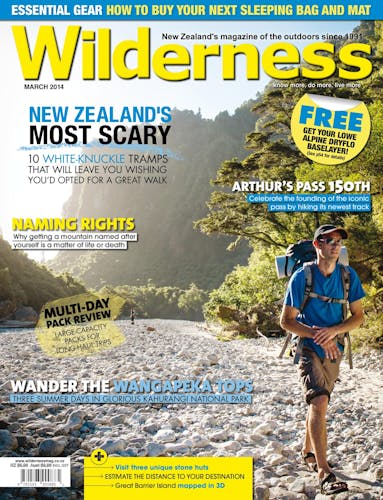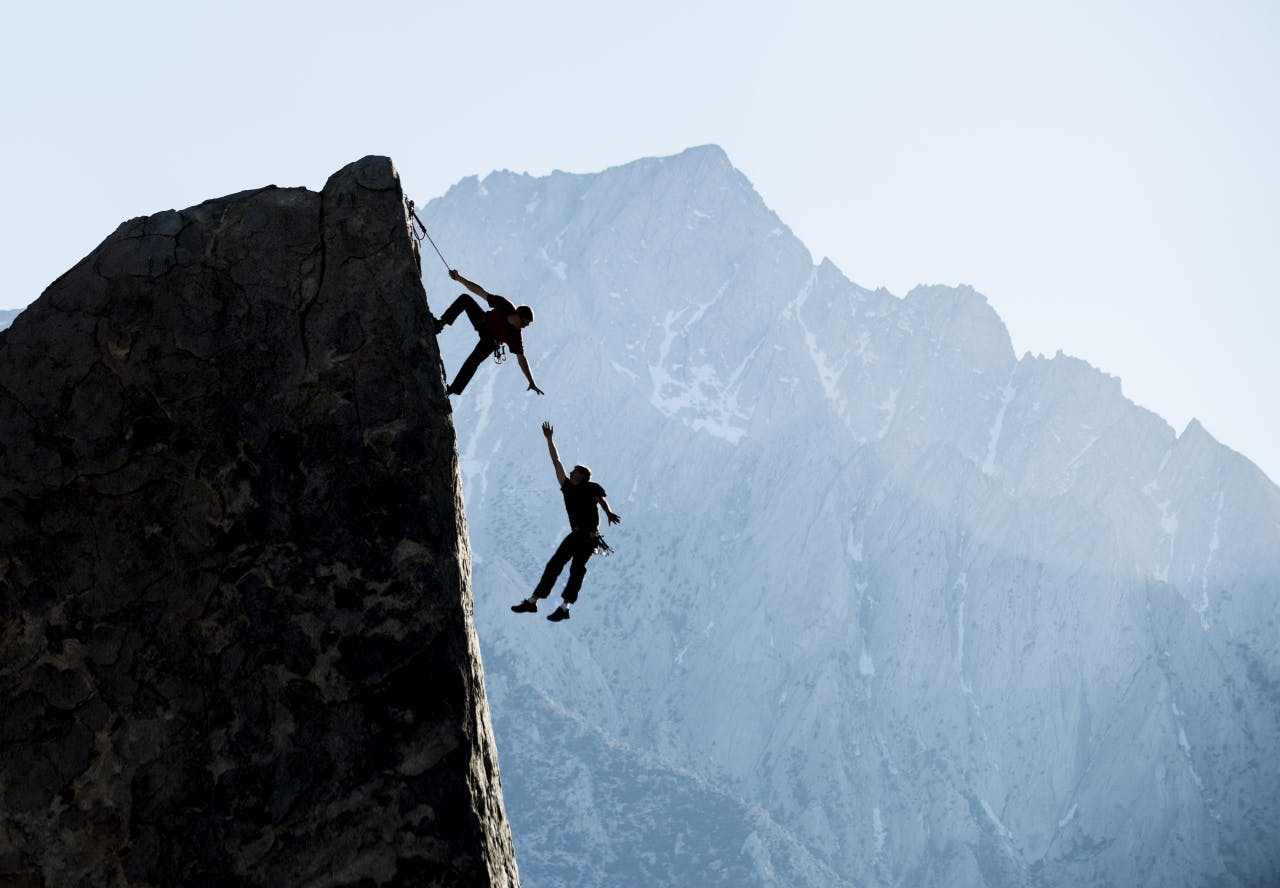It happens all the time: a tramper commits to an horrendously exposed move only to find halfway through, their nerve has left them. Unable to go forward or retreat, what’s the best course of action?
A friend of mine wanted to kill himself. Not for long. Just for a few moments.
Nathan* was hanging from an ice cliff on a near-vertical slope on Mt Brewster. He was poorly equipped. He had one ice pick when he should have had two. He wore hired crampons and had no rope.
The surface of the ice had hardened to the extent that he could only jam his ice pick and crampons in a few millimetres and he could feel blood soaking his damaged toes. He had earlier seen his climbing buddy – the fitter and more agile of the two – struggle to traverse a particularly unpleasant patch of ice. His buddy made it, but Nathan knew that patch would be harder for him.
When he reached it he was exhausted. He was woefully unfit for such a climb and the front points on his crampons were barely keeping him attached to the wall.
He held his ice axe in his left arm and whacked it against the ice. It pinged back, not even scratching the surface. He tried again with as much force as he dare without dislodging his feet. Same result. He tried with his left boot but made no inroads. His foot bounced back just like his ice axe had done.
“I hugged the mountain,” Nathan explains. “At that point I looked over my left shoulder. I realised how steep it was and I could see where the glacier had broken from the mountainside to create a huge crevasse a long way below me.”
But there was no way Nathan could head down, he’d passed the point of no return without realising. The trouble was he couldn’t continue either.
“I thought ‘I’m stuck, I’m in the s*** here’. I was trembling and at that point I was physically and emotionally vulnerable. If the next move wasn’t a secure one, I was a dead man.
“At that point it was as if a door opened in my mind. Inside rushed a fear. The fear was that I had no way of going anywhere but off the mountain. I couldn’t stay there because I was physically deteriorating. I remember thinking ‘I can’t even stay here – I can’t hold on any longer – I’m going to slide off’.
“What really shocked me to this day is that I thought of just letting go. The thought of that was better than the feeling of falling and sliding.”
His climbing buddy realised Nathan was in trouble. “What are you doing? You have to keep moving!” he yelled down at him.
“I can’t get across this thing,” Nathan yelled back.
“You’ve got to trust your front points,” shouted his buddy. “Trust your front points! Move! You’ve got to go!”
Nathan managed to overcome the rush of fear and focus instead on the next step. He had been within seconds of letting himself drop, but decided to give it a try, no matter how hopeless it seemed.
“I decided to trust my left leg and I slammed it in to the ice,” he says. “I was in agony. I let the weight go in my right leg and trusted what was going to happen. I was only in 1-2mm but somehow it held my weight and I did the same with my right leg. I didn’t want to go in too hard because any movement would send me downwards.
“Somehow I got across the hard stuff and I could move across and up again – but by this stage I was an emotional wreck. I remember hauling myself up to the ridge half an hour later and I slumped over it like a rag doll.”
This chilling account is something no climber wants to experience. But is there a trick to hauling yourself through a situation like this? And if you’re with someone who freezes to the spot, what should you do?
Nathan admits he made some terrible errors of judgement in the lead-up to the incident, largely down to ego.
“When climbing with someone you need to be honest with each other about what you can and can’t do,” he says. “I remember my buddy asking ‘Are you ok with this?’ and I said ‘Yes’. When I got closer and realised it was much steeper than I thought, I didn’t pull out. I think it was bravado that made me continue.
“At any time I could have said ‘This isn’t for me, I’m going down’. He would have come down with me, though I would never have heard the end of it!
“In hindsight, I was not experienced enough to climb what we climbed and we were poorly equipped.”
But he has lived to tell the tale thanks to calming himself at the vital moment.
“Clearing the mind of that horrible fear and getting back to survival instinct helped to get me through,” he says. “I knew I needed to try something rather than nothing, even though that option seemed impossible. My climbing partner screaming at me to move also helped. I could follow an outside influence – an instructor who wasn’t myself.”
Finding a way to calm himself was absolutely vital according to the Mountain Safety Council’s Andrew Hobman. Hobman says if anyone finds themselves in a similar situation, they should do likewise.
“Anxiety can turn into panic and this can be triggered by a number of things, such as exposure, tiredness or even the sun going off the slope making the place look more hostile,” says Hobman.
“You need to control this panic with long, focussed breaths, breathing in through the nose. Then you refocus on a singular thing. Plan what to do next, mentally go through it in your mind, then go for it. You can’t hang there for too long, you have to keep moving.”
Hobman adds that the climbing partner of someone who gets into trouble can be instrumental in the recovery, so long as they react sensibly.
“You must be calm and organised,” he says. “You should always offer encouragement and be patient with them. Their anxiety may be irrational, but they’re still feeling it. You might have to plan what they do step by step and talk them through it without pressuring them.”
Of course, the ideal scenario is ensuring you don’t get into the situation in the first place. This isn’t always easy, with changes in weather, ground conditions and circumstance, but Hobman says there are ways to reduce the risk.
“Probably the biggest thing is knowing your limits and the limits of your climbing partners. It’s not just the limit of your ability, but how you deal with situations. If there’s something that may make you anxious, let people know at the beginning.
“Climbers don’t have to be best friends, but it’s important to know each other to a level. Each should know how the other’s feeling mentally, how much experience they have, whether they’ve had a bad week. It’s all important stuff to know.
“The most dangerous thing is to keep worries inside and not talk about them – you should be talking the whole time.”
The importance of communication is echoed by Jamie Fitzgerald, a host on the TV series First Crossings. Fitzgerald first met co-host Kevin Biggar when Biggar invited him to take part in a rowing race across the Atlantic Ocean just three weeks before the race began. They’d never met before yet managed to not only win the race, but do it in world record time.
Several years later, the pair combined once more on a mission to the South Pole. Fitzgerald believes the kind of relationship he has with Biggar has meant both have helped each other when they feel they can’t go on.
“More often than not, if Kevin’s having a bad day, the chances are I’m not having such a bad day because of the way I see the world,” says Fitzgerald. “It’s the same the other way round.
“We’ve become really good at being open about how we feel – we talk about our emotions a lot. That doesn’t sound very macho but we don’t care about that.”
It’s this approach that has seen Fitzgerald and Biggar through situations that would finish off less trusting companions.
“In the Atlantic we were hit by a wave at 10pm and got thrown into the ocean,” recalls Fitzgerald. “Neither of us were connected to the boat by safety lines. We were thinking ‘how do we get out of this’?
“The thing that helped us to get through was Kevin’s analytical process mind and my communication point of view. We had the perfect balance to assess what we had on board and whether we were mentally in a good place to carry on.
“Your best mate isn’t always the best person to take with you. There are plenty of occasions when best mates have never spoken to each other again. There was one time where two rowers from the UK were on their own in the middle of the Atlantic and one said to the other: ‘About your wife and I…’. It turned out they’d been having an affair!”
Nathan, the out-of-his-depth ice climber, admits that without the encouragement of his climbing buddy, he may not have found it within himself to carry on. Land Search and Rescue say when they’re called out in similar circumstances it’s normally by people climbing on their own, who have fallen or have reached a ledge and daren’t move.
“Almost all the people we’ve rescued in these situations have been by themselves,” says Hamish Reid, an Arthur’s Pass LandSAR member. “If they’re in a group, their friends are normally able to assist them but on their own there’s no-one to call on to talk them through it.
“We rescued an English chap from Mt Cassidy. He was so calm – he’d even taken photographs of sunset the evening before. He was stuck in a gully with one buttock perched on a ledge. His buttock was dead by the time we got there but he was fine. He’d left good intentions so he knew someone would call the police.
“On the other hand, there was a guy on Mt Rolleston who’d been stuck for two nights and we rescued him on the third. He’d gone through all sorts of emotional turmoil, from being optimistic about recovery to writing a letter to his wife saying he didn’t think he would survive. His psychological reserves were well and truly tested.”
No two situations are the same. And no one piece of advice can be useful for every circumstance. But should you ever find yourself in a situation where you think you’re for it, the overriding message that should run through your brain is the same as that given by the British Government to its people before the Second World War: ‘keep calm and carry on’.
Or, perhaps the variant: ‘keep calm and go back’








